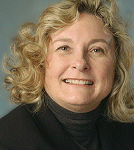How to Be a Super Tech Leader
- By Dian Schaffhauser
- 07/01/08
These eight 'gender-blind' secrets of career success have helped one woman become a campus tech leader. They'll work for you, too!
 MARY JO GORNEY-MORENO DIDN'T START OUT in IT. She joined San Jose State University (CA) in 1981 as an assistant professor in the school of nursing. But somewhere along the way, she realized her energy was focused on academic technology, and how it could help a variety of learners gain knowledge.
MARY JO GORNEY-MORENO DIDN'T START OUT in IT. She joined San Jose State University (CA) in 1981 as an assistant professor in the school of nursing. But somewhere along the way, she realized her energy was focused on academic technology, and how it could help a variety of learners gain knowledge.
Now associate VP of academic technology for San Jose State, Gorney-Moreno led the effort to design and implement the university's Academic Success Center, a 10,000-square-foot incubator learning space, which she now directs. She's also the director of faculty development for the university. How did her ascension in the tech arena come about? During her 27 years at San Jose, says the VP, she was fortunate to discover eight secrets of career success that continually propelled her forward.
Secret #1: Broaden Your Horizons
In other words, says Gorney-Moreno, get involved in the broader operations of your campus. In her own case, that "broadening" came through terms she served in the academic senate where faculty and administrators were responsible for decisions that affected the entire university. "I've always been excited by processes and how organizations operate," she says. Her time in the senate, which included stints as senate chair, taught her how a university is administered, how funds are procured for different projects, and how decisions are made. She viewed her time there as an opportunity to improve faculty lives-- and, indirectly, the students' lives, too. "If the faculty are happier and more satisfied with their role, then it affects the students as well."
Secret #2: Communicate!
Are you communicating your projects to the university community? Gorney-Moreno, for instance, learned to communicate about research she conducted regarding the use of technology for nursing education. That research included video-based delivery of curricula as well as a project that explored the use of PDAs to connect homecare nursing students with instructors, and instructors with physicians. As she brought these technology-based projects to the campus, she kept the president and the provost apprised of progress; she also informed them of project awards, new funding resources, and the application of those funds. At a project's close, she made sure to invite the university's senior administrators to the celebration, so that they could speak with the students involved in the initiatives, and view the technology in action.
"I believed it was my job to let the campus administration know what we were doing," she maintains, but adds that her actions had another effect: They made the administration aware that she was one of the faculty on campus who was on the forefront of technology-based research. When the post of associate VP/academic technology opened up, the president and provost asked if she'd be willing to take the job on an interim basis.
Secret #3: Be an Insider
After her promotion, instead of going out and looking for funding to tackle various projects, Gorney-Moreno was in a position to help facilitate others' projects, a role she relished. "I thought I had the best job on campus," she says. After a national search for the permanent post, five finalists were in the running, including Gorney-Moreno. That's when she used her "insider" advantage.
"Because I had been a faculty member on this campus for about 20 years, I was able to speak effectively to areas that needed change," she recalls. "One benefit of being an inside candidate: You can quickly develop this kind of needs assessment." That included the ability to identify available funds to address those needs-- a skill she picked up from her time in the academic senate. What's more, Gorney- Moreno had already proved her ability to deliver, plus she had insider ties to the campus segment most resistant to tech innovation. In its offer letter, the hiring committee cited the fact that she'd completed several innovation projects already, and was somebody who would be quickly accepted by the campus, particularly the faculty.
Secret #4: Once Inside, Get Outside
In order to succeed in her new position, Gorney-Moreno needed to expand her understanding of technology. That's when she recalled advice from her predecessor: "Be off campus once a week." In Silicon Valley, teeming with technology conferences, seminars, and workshops, this wasn't hard to do.
She also joined three organizations: 1) the Directors of Academic Technology, which represents the administrative staff at California State University campuses responsible for integrating IT into the learning and teaching environment; 2) Exceptional Women Executives, an SJSU alumni association; and 3) an IT advisory committee, which also operated across the CSU system. She became active in industry associations and began visiting corporate and academic IT organizations in the region. In short, she expanded her technology education and her understanding of best practices, and enhanced her professional network.

"Because I had been a faculty member on this campus for 20 years, I was able to speak effectively to areas that needed change. One benefit of being an inside candidate: You can quickly develop this kind of needs assessment."
Secret #5: Head to Boot Camp
The new tech VP's education really took off during an intensive two weeks at Emory University's (GA) annual Frye Leadership Institute. The program draws IT professionals, librarians, and administrators who want to help define and transform academic information services within their schools. "The institute really catapulted me to the next level of understanding IT from the viewpoint of the campus," she says. "How often in mid-career do you get a chance to make 40 or 50 new best friends who are specialists in your area and who are available to you 24/7?" Now when Gorney-Moreno needs feedback, she posts it to the Frye listserv and gets responses within hours.
Secret #6: Form Partnerships, Build Coalitions
The first project Gorney-Moreno faced in her new role was a redesign of the university's website. As a first step, she put together an advisory board for the discovery process, with 12 individuals representing every major constituency on campus. Because she had served in the senate and knew the "players," when she called, they signed on. Gorney-Moreno advises: "Demonstrate early on that you're consensus-building; that you're not a silo maker; and that everybody can sit at your table and share their opinions."
Secret #7: Think Mentoring 2.0
Traditionally, newcomers to a field seek out experienced members to advise and provide guidance on career and organizational matters. Commonly, female professionals seek other females to serve in that capacity. Gorney-Moreno didn't exactly go that route.
In truth, the dearth of women in her field put her off at first. "I remember the first big IT event that I attended," she recalls. "There were about 100 people in the room; six were women. My first thought was: Can I do this? Is this a battle I want to fight?"
What kept her going was that in a university setting, people are used to sharing information. Then, at a DAT meeting in San Diego, she met James Frazee, an associate director of instructional technology at San Diego State University who looked like a young "surfer dude," but was working on his doctorate in IT. Unexpectedly, he became her mentor.
"Had I gone into it looking for a mentor, I would have picked someone older," says Gorney-Moreno. "But he was very bright, with outstanding ideas, doing great things, and [representing] a unit that was obviously making more progress than San Jose State at that time." She brought Frazee to San Jose to consult with her team members about how they could develop their 21st century skills. Frazee (now in a director position) and his protégé have since reversed roles many times: Gorney-Moreno, for instance, helped Frazee's group understand the finer points of setting up a laptop program, an initiative she launched several years ago. "It really has been a reciprocal relationship," she maintains. "Sometimes he's the mentor and sometimes I am."
Secret #8: Exploit Your Superpowers
Gorney-Moreno admits that much of her career success has resulted from "being in the right place at the right time-- and having people know you have a set of skills." But she's also taken on projects with which she had no direct experience, and she's made them work by tapping other powers she's developed throughout her career. One of those powers came from a lesson she picked up at Frye: to know how to create an "elevator" speech-- a short, powerful snapshot of what you're trying to get across. Without this skill, it's exceedingly hard to move projects forward, or sell them internally. "Wherever I move about the campus, I recite the same mantra," she says, "until people really understand what I'm about and what I want to do."
Exploiting all the powers she's collected in her toolbox pays off for the campus, and for her own personal career development, she says. "Every two years, the campus comes up with a new challenge, and I get to educate myself in a totally new field."